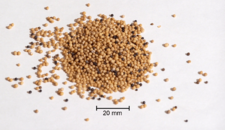Mustard seed facts for kids
 |
|
| Nutritional value per 100 g (3.5 oz) | |
|---|---|
| Energy | 2,126 kJ (508 kcal) |
|
28.09 g
|
|
| Sugars | 6.79 g |
| Dietary fiber | 12.2 g |
|
36.24 g
|
|
| Saturated | 1.989 g |
| Monounsaturated | 22.518 g |
| Polyunsaturated | 10.088 g |
|
Protein
|
26.08 g
|
| Vitamins | Quantity
%DV†
|
| Vitamin A equiv. |
0%
2 μg |
| Thiamine (B1) |
70%
0.805 mg |
| Riboflavin (B2) |
22%
0.261 mg |
| Niacin (B3) |
30%
4.733 mg |
| Vitamin B6 |
31%
0.397 mg |
| Folate (B9) |
41%
162 μg |
| Vitamin B12 |
0%
0 μg |
| Vitamin C |
9%
7.1 mg |
| Vitamin E |
34%
5.07 mg |
| Vitamin K |
5%
5.4 μg |
| Minerals | Quantity
%DV†
|
| Calcium |
27%
266 mg |
| Iron |
71%
9.21 mg |
| Magnesium |
104%
370 mg |
| Phosphorus |
120%
841 mg |
| Potassium |
28%
828 mg |
| Sodium |
1%
13 mg |
| Zinc |
64%
6.08 mg |
| Other constituents | Quantity |
| Water | 5.27 g |
| †Percentages estimated using US recommendations for adults. | |
Mustard seeds are the small round seeds of various mustard plants. The seeds are usually about 1 to 2 millimetres (0.039 to 0.079 in) in diameter and may be colored from yellowish white to black. They are an important spice in many regional foods and may come from one of three different plants: black mustard (Brassica nigra), brown Indian mustard (B. juncea), or white/yellow mustard (B. hirta/Sinapis alba).
Grinding and mixing the seeds with water, vinegar or other liquids creates the yellow condiment known as prepared mustard.
Regional use
Mustard seeds are used as a spice in the Indian subcontinent. The seeds are usually fried until they pop. The leaves are also stir-fried and eaten as a vegetable. In Maharashtra, mustard oil is used for body massage during extreme winters, as it is thought to keep the body warm. In Bengali cuisine mustard oil or shorsher tel is the predominant cooking medium. Mustard seeds are also essential ingredients in spicy fish dishes like jhaal and paturi. A variety of Indian pickles consisting mainly of mangoes, red chili powder, and powdered mustard seed preserved in mustard oil are popular in southern India.
In North America, mustard seeds are used in spices and condiments. Yellow mustard is popular in the United States and is often used as a condiment in sandwiches and other dishes. Mustard seeds are first ground into a powder and then mixed with other ingredients to create this condiment. Roughly 1,000 seeds are used in manufacturing just 8oz of mustard.
Cultivation
Mustard seeds generally take eight to ten days to germinate if placed under the proper conditions, which include a cold atmosphere and relatively moist soil. Mature mustard plants grow into shrubs.
Yellow mustard has a plant maturity of 85 to 90 days; whereas, brown and oriental mustard have a plant maturity of 90 to 95 days. If the temperature conditions are conducive to growth, a mustard plant will begin to bud five weeks after the seedlings have appeared. The plant will reach full bloom 7 to 10 days later. Brown or oriental varieties of mustard tend to have higher yields compared to yellow mustard. Seed yield is also related to the bloom period. In other words, the longer the bloom period, the greater the seed yield.
Mustard grows well in temperate regions. Major producers of mustard seeds include India, Pakistan, Canada, Nepal, Hungary, Great Britain and the United States. Brown and black mustard seeds return higher yields than their yellow counterparts.
In Pakistan, rapeseed-mustard is the second most important source of oil, after cotton. It is cultivated over an area of 307,000 hectares with an annual production of 233,000 tonnes and contributes about 17% to the domestic production of edible oil.
Mustard seeds are a rich source of oil and protein. The seed has oil as high as 46-48%, and whole seed meal has 43.6% protein.
Production
| Country | Production (tonnes) | Footnote | |||
|---|---|---|---|---|---|
| 233,000 | |||||
| 200,000+ | |||||
| 154,500 | |||||
| 142,920 | |||||
| 91,000 | - | 54,682 | |||
| 30,170 | |||||
| 17,000 | F | ||||
| 16,660 | |||||
| 14,000 | F | ||||
| 13,378 | |||||
| 10,500 | F | ||||
| World | 571,880 | A | |||
| * = Unofficial figure | [ ] = Official data | A = May include official, semi-official or estimated data F = FAO estimate | Im = FAO data based on imputation methodology | M = Data not available Source: UN Food and Agriculture Organization (FAO) |
|||||
In North America, mustard is produced as a specialty crop. Majority of the production is found in upper Midwest United States and Canada. In 2020, the total production of mustard in the United States was 81.8 million pounds (37.1 kt).
Other uses
Ground mustard seed meal is used as a natural soil amendment for soil borne disease management in other crops.
Diseases
Mustard seeds carry seed borne pathogens which affect germination rate, as any other seed. Latif et al., 2006 isolate Alternaria, Aspergillus, Chaetomium, Curvularia, Fusarium, Penicillium, and Rhizopus in Bangladesh.
See also
 In Spanish: Granos de mostaza para niños
In Spanish: Granos de mostaza para niños

